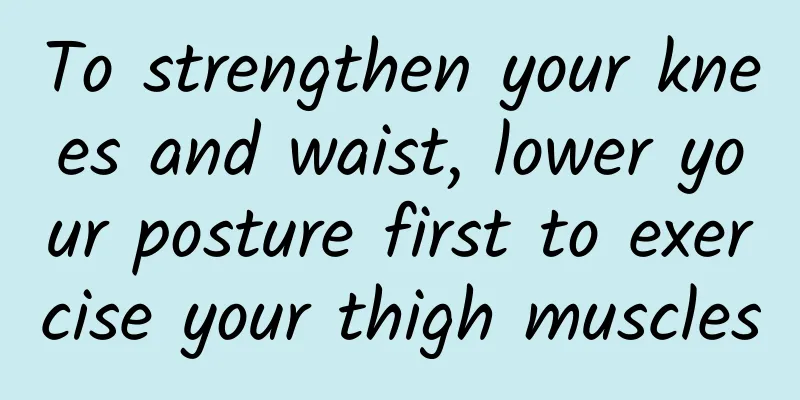To strengthen your knees and waist, lower your posture first to exercise your thigh muscles

|
Pain is a common problem in the waist, neck, knees, legs, etc. Sports rehabilitation experts say that to relieve pain, you need to rely on key muscles! Because muscles play an important role in joint function, the erector spinae muscles in the waist, the quadriceps femoris in the knees, the peroneus muscles in the ankles, and the rotator muscles in the shoulders are the most representative. Strengthening these muscles is necessary if you want to avoid injuries and prevent pain in your musculoskeletal system. The thickness of your thighs determines the health of your knees and waist Taking thigh muscles as an example, it turns out that “the thickness of thighs determines the health of knees and waist”. Why? The thigh muscles are composed of the quadriceps femoris (four muscles: vastus lateralis, rectus femoris, vastus intermedius, vastus medialis) and the posterior thigh muscles (Hamstring, three muscles: biceps femoris, semitendinosus, semimembranosus). The muscles in the front and back of the thigh balance each other, and are mainly used when bending and straightening the knee, and when bending and extending the hip joint forward, backward, left and right, and the thigh muscles also work when turning. The long quadriceps muscle called the rectus femoris attaches to the kneecap, passes through the knee joint, and connects to the hip joint. The same goes for the hamstring muscles at the back, which start at the ilium, pass through the knee, and connect to the tibia just below the knee. This thigh muscle supports the hips and torso and transmits energy to the area below the knee. Although they work in pairs, if they are in an unbalanced situation, it may cause rupture of knee ligaments or muscles. In addition, when you sit down and stand up, when you bend over and straighten up again during exercise or daily life, the posterior thigh muscle groups and thigh muscles trained through exercise can reduce the burden on the waist muscles and thus protect the waist. The thigh muscles are also responsible for dissipating the vertical pressure of body weight on the knees when walking or jumping. Therefore, weakened thigh muscles can lead to degenerative arthritis and cause knee instability. In summary, the thigh muscles are used to support the hips and torso, and have the function of transmitting energy to the area below the knees. The thigh muscles play a core role in maintaining body balance, so exercising thigh muscle strength is a very important exercise! Sports rehabilitation expert Wen Xunji recommends "lowering posture exercises" in his new book "5-Minute Quick Stretch to Relieve Pain". This exercise can be performed while lying down, lying on your stomach, or sitting. If your knees are weak, it's okay to tie sandbags around your ankles at the beginning. If you are even more vulnerable, you can use the weight of your legs to do leg-lifting exercises, which is also quite effective. People who are strong can hang up weights in the gym to do leg exercises. Exercising your thigh muscles through continuous exercise like this will be of great help to your knee joints and waist. To treat your body, you need to overcome the painful areas through stretching exercises! The following is a set of stretching exercises for the knees and waist: [Knee and front thigh strengthening exercises] Strengthens the front thigh muscles (quadriceps) and kneecap, reducing knee pain and increasing stability. Please operate within the limits that do not cause pain. 1. Sit down and relax, place your hands behind your back, lean your upper body back slightly, and then stand on one foot. Straighten your other foot and place the rolled towel under your ankle. 2. Gently press the knees on the towel so that they are close to the ground. Apply force to the front of your thigh to hook the instep towards your body and hold for 6 seconds. Repeat the same action 6 times, and then change feet using the same method. 【Lying waist pelvic tilt exercise】 Strengthens the abdominal muscles (rectus abdominis, pelvic floor muscles), while also allowing for more flexible movement in the hips. 1. Lie flat on the ground with your knees bent. 2. Place your arms under your head, keep your hips close to the ground, and use your waist to lift up gently, hold for 6 seconds. Key points: Inhale with your abdomen when you lift your waist, and exhale when you lower your waist. 3. On the contrary, keep your waist close to the ground, lift your hips slightly and hold for 6 seconds. 4. Repeat steps ② and ③ 6 times. |
<<: Can drinking coffee improve fatty liver? Nutritionist's 3 best things revealed
Recommend
The best and fastest treatment for chronic pelvic inflammatory disease
What is the best and fastest treatment for chroni...
What are the symptoms of pelvic inflammatory disease?
What are the symptoms of pelvic inflammatory dise...
Empty your stomach! Burdock can help you lose weight and treat constipation, and it can also help you maintain smooth and beautiful skin.
The secret to a diet that makes you look younger ...
Which hospital is good for menopause treatment?
Nowadays, more and more girlfriends are suffering...
Can I eat oranges after a miscarriage? I should try to eat less
Many people like to eat oranges. Among all fruits...
What causes menstruation to come one week early?
What causes menstruation to come one week early? ...
What are the ways to avoid threatened miscarriage?
Threatened abortion is a common gynecological dis...
Korean star Suzy lost 13 kg by eating sweet potato meals! Nutritionist Cheng Hanyu reveals: 5 ways to eat sweet potatoes for weight loss
Many people are afraid of getting fat and dare no...
Misunderstood! Should your knees not go beyond your toes when squatting? Chiropractor teaches 3 principles for correct squatting
The benefits of "squats" include streng...
7 Diet Traps to Watch Out for When Eating Out and Want to Lose Weight
Many people must have encountered this kind of tr...
What should I do if I have postmenopausal bleeding?
What should I do if I have postmenopausal bleedin...
Hollywood actresses love hot yoga, not only for sculpting bodies and relieving stress, but also for "these" unexpected benefits!
American actress Jennifer Aniston is a well-known...
What are the diagnostic methods for female cervical warts?
Completely curing the disease is the wish of many...
What are the dangers of ovarian cysts?
Any disease has its harmfulness, but some are mor...
How is cervicitis diagnosed?
Cervicitis is one of the common diseases among wo...









